Review on Dynamic Recrystallization of Martensitic Stainless Steels during Hot Deformation: Part I—Experimental Study
Abstract
:1. Introduction
2. Hot Formability of MSS
3. Dynamic Recrystallization of MSS under Hot Deformation
4. Analysis of MSS Flow Stress under Hot Deformation
5. Precipitates and Dislocations
6. Summary and Further Investigation
Author Contributions
Funding

Institutional Review Board Statement
Informed Consent Statement
Data Availability Statement
Conflicts of Interest
References
- Stichel, W. ASM speciality handbook: Stainless steels. Hrsg. von J. R. Davis, 577 S., ASM International, Materials Park, Ohio, USA, 1994, £ 136.00 (ASM Member £ 102.00) ISBN 0-87170-503-6. In Europa zu beziehen durch: American Technical Publishers Ltd, 27–29 Knowl Pi. Mater. Corros. 1995, 46, 499. [Google Scholar] [CrossRef]
- Hara, T.; Semba, H.; Amaya, H. Pipe and Tube Steels for Oil and Gas Industry and Thermal Power Plant; Elsevier: Amsterdam, The Netherlands, 2020; ISBN 978-0-12-803581-8. [Google Scholar]
- Iannuzzi, M. Environmentally assisted cracking (EAC) in oil and gas production. In Woodhead Publishing Series in Metals and Surface Engineering; Raja, V.S., Shoji, T.B.T.-S.C.C., Eds.; Woodhead Publishing: Sawston, UK; Cambridge, UK, 2011; pp. 570–607. ISBN 978-1-84569-673-3. [Google Scholar]
- Kim, M.-S.; Park, K.-S.; Kim, D.-I.; Suh, J.-Y.; Shim, J.-H.; Hong, K.T.; Choi, S.-H. Heterogeneities in the microstructure and mechanical properties of high-Cr martensitic stainless steel produced by repetitive hot roll bonding. Mater. Sci. Eng. A 2021, 801, 140416. [Google Scholar] [CrossRef]
- Kassis, K.; Masmoudi, J.; Kolsi, A.W.; Dubois, B. Effect of phosphorus on the formation of titanium carbide in 17% Cr ferritic steels stabilized with titanium. Rev. Met. Paris 2004, 101, 685–693. [Google Scholar] [CrossRef]
- Singh, R. Welding Corrosion Resistant Alloys—Stainless Steel; Singh, R.B.T.-A.W.E., Ed.; Butterworth-Heinemann: Boston, MA, USA, 2012; Chapter 6; pp. 191–214. ISBN 978-0-12-391916-8. [Google Scholar]
- Darvell, B.W. Steel and Cermet. In Woodhead Publishing Series in Biomaterials; Darvell, B.W.B.T.-M.S., Tenth, E., Eds.; Woodhead Publishing: Sawston, UK; Cambridge, UK, 2018; Chapter 21; pp. 540–554. ISBN 978-0-08-101035-8. [Google Scholar]
- Dong, J.; He, Y.; Kim, M.; Shin, K. Effect of Creep Stress on the Microstructure of 9–12% Cr Steel for Rotor Materials. Microsc. Microanal. 2013, 19, 95–98. [Google Scholar] [CrossRef] [PubMed] [Green Version]
- Manilova, E. Examination of Minor Phases in Martensitic 12% Cr-Mo-W-V Steel. Microsc. Microanal. 2006, 12, 1612–1613. [Google Scholar] [CrossRef] [Green Version]
- Tanaka, T. Fatigue Strength: Improving by Surface Treatment; Buschow, K.H.J., Cahn, R.W., Flemings, M.C., Ilschner, B., Kramer, E.J., Mahajan, S., Veyssière, P.B.T.-E., Eds.; Elsevier: Oxford, UK, 2001; pp. 2990–2994. ISBN 978-0-08-043152-9. [Google Scholar]
- Garrison, W.M. Stainless Steels: Martensitic; Buschow, K.H.J., Cahn, R.W., Flemings, M.C., Ilschner, B., Kramer, E.J., Mahajan, S., Veyssière, P.B.T.-E., Eds.; Elsevier: Oxford, UK, 2001; pp. 8804–8810. ISBN 978-0-08-043152-9. [Google Scholar]
- Somers, M.A.J.; Christiansen, T.L. Gaseous Processes for Low Temperature Surface Hardening of Stainless Steel; Mittemeijer, E.J., Somers, M.A.J.B.T.-T.S.E., Eds.; Woodhead Publishing: Oxford, UK, 2015; pp. 581–614. ISBN 978-0-85709-592-3. [Google Scholar]
- Webster, D. Development of a high strength stainless steel with improved toughness and ductility. Metall. Mater. Trans. B 1971, 2, 2097–2104. [Google Scholar] [CrossRef]
- Villalobos, J.C.; Del-Pozo, A.; Campillo, B.; Mayen, J.; Serna, S. Microalloyed Steels through History until 2018: Review of Chemical Composition, Processing and Hydrogen Service. Metals 2018, 8, 351. [Google Scholar] [CrossRef] [Green Version]
- Krauss, G. Physical Metallurgy of Steels: An Overview**Every Effort has been Made to Trace Copyright Holders and to Obtain their Permission for the Use of Copyright Material. The Publisher Apologizes for Any Errors or Omissions in the Acknowledgements; Rana, R., Singh, S.B.B.T.-A.S., Eds.; Woodhead Publishing: Sawston, UK; Cambridge, UK, 2017; pp. 95–111. ISBN 978-0-08-100638-2. [Google Scholar]
- Yang, Q.; Zhou, Y.; Li, Z.; Mao, D. Effect of Hot Deformation Process Parameters on Microstructure and Corrosion Behavior of 35CrMoV Steel. Materials 2019, 12, 1455. [Google Scholar] [CrossRef] [Green Version]
- Magnee, A.; Drapier, J.M.; Coutsouradis, D.; Habrakan, L.; Dumont, J. Cobalt-Containing High-Strength Steels; IAEA Report: Brussels, Belgium, 1974. [Google Scholar]
- Pickering, F.B. Physical Metallurgy and the Design of Steels/F. B. Pickering; Materials Science Series; Applied Science Publishers: London, UK, 1978; ISBN 0853347522. [Google Scholar]
- Zhang, H.; Wei, Z.; Xie, F.; Sun, B. Assessment of the Properties of AISI 410 Martensitic Stainless Steel by an Eddy Current Method. Materials 2019, 12, 1290. [Google Scholar] [CrossRef] [Green Version]
- Harsha, A.-P.; Limaye, P.-K.; Tyagi, R.; Gupta, A. Effect of Temperature on Galling Behavior of SS 316, 316 L and 416 Under Self-Mated Condition. J. Mater. Eng. Perform. 2016, 25, 4980–4987. [Google Scholar] [CrossRef]
- Ben Lenda, O.; Tara, A.; Lazar, F.; Jbara, O.; Hadjadj, A.; Saad, E. Structural and Mechanical Characteristics of AISI 420 Stainless Steel After Annealing. Strength Mater. 2020, 52, 71–80. [Google Scholar] [CrossRef]
- Giordana, M.F.; Alvarez-Armas, I.; Armas, A. On the Cyclic Softening Mechanisms of Reduced Activity Ferritic/Martensitic Steels. Steel Res. Int. 2012, 83, 594–599. [Google Scholar] [CrossRef]
- Landon, P.R.; Caligiuri, R.D.; Duletsky, P.S. The influence of the M23 (C,N)6 compound on the mechanical properties of type 422 stainless steel. Metall. Trans. A 1983, 14, 1395–1408. [Google Scholar] [CrossRef]
- Hemmati, I.; Ocelík, V.; De Hosson, J.T.M. Microstructural characterization of AISI 431 martensitic stainless steel laser-deposited coatings. J. Mater. Sci. 2011, 46, 3405–3414. [Google Scholar] [CrossRef] [Green Version]
- Huang, C.A.; Tu, G.C.; Yao, H.T.; Kuo, H.H. Characteristics of the rough-cut surface of quenched and tempered martensitic stainless steel using wire electrical discharge machining. Metall. Mater. Trans. A 2004, 35, 1351–1357. [Google Scholar] [CrossRef]
- Venske, A.F.; de Castro, V.V.; da Costa, E.M.; dos Santos, C.A. Sliding Wear Behavior of an AISI 440B Martensitic Stainless Steel Lubricated with Biodiesel and Diesel–Biodiesel Blends. J. Mater. Eng. Perform. 2018, 27, 5427–5437. [Google Scholar] [CrossRef]
- Hasan, S.; Thamizhmanii, S. Tool flank wear analyses on AISI 440 C martensitic stainless steel by turning. Int. J. Mater. Form. 2010, 3, 427–430. [Google Scholar] [CrossRef]
- Aghaie-Khafri, M.; Adhami, F. Hot deformation of 15-5 PH stainless steel. Mater. Sci. Eng. A 2010, 527, 1052–1057. [Google Scholar] [CrossRef]
- Zukerman, I.; Raveh, A.; Kalman, H.; Klemberg-Sapieha, J.E.; Martinu, L. Thermal stability and wear resistance of hard TiN/TiCN coatings on plasma nitrided PH15-5 steel. Wear 2007, 263, 1249–1252. [Google Scholar] [CrossRef]
- Yu, W.-T.; Li, J.; Shi, C.-B.; Zhu, Q.-T. Effect of Spheroidizing Annealing on Microstructure and Mechanical Properties of High-Carbon Martensitic Stainless Steel 8Cr13MoV. J. Mater. Eng. Perform. 2017, 26, 478–487. [Google Scholar] [CrossRef]
- Rafi, H.K.; Starr, T.L.; Stucker, B.E. A comparison of the tensile, fatigue, and fracture behavior of Ti–6Al–4V and 15-5 PH stainless steel parts made by selective laser melting. Int. J. Adv. Manuf. Technol. 2013, 69, 1299–1309. [Google Scholar] [CrossRef]
- Mortezaei, S.; Arabi, H.; Seyedein, H.; Momeny, A.; Soltanalinezhad, M. Investigation on Microstructure Evolution of a Semi-Austenitic Stainless Steel Through Hot Deformation TT. IUST 2020, 17, 60–69. [Google Scholar] [CrossRef]
- Azizpour, A.; Hahn, R.; Klimashin, F.F.; Wojcik, T.; Poursaeidi, E.; Mayrhofer, P.H. Deformation and Cracking Mechanism in CrN/TiN Multilayer Coatings. Coatings 2019, 9, 363. [Google Scholar] [CrossRef] [Green Version]
- Murayama, M.; Hono, K.; Katayama, Y. Microstructural evolution in a 17-4 PH stainless steel after aging at 400 °C. Metall. Mater. Trans. A 1999, 30, 345–353. [Google Scholar] [CrossRef]
- Reddy, V.V.; Kumar, A.; Valli, P.M.; Reddy, C.S. Influence of surfactant and graphite powder concentration on electrical discharge machining of PH17-4 stainless steel. J. Braz. Soc. Mech. Sci. Eng. 2015, 37, 641–655. [Google Scholar] [CrossRef]
- He, J.; Chen, L.; Tao, X.; Antonov, S.; Zhong, Y.; Su, Y. Hydrogen embrittlement behavior of 13Cr-5Ni-2Mo supermartensitic stainless steel. Corros. Sci. 2020, 176, 109046. [Google Scholar] [CrossRef]
- An, G.; Liu, R.; Yin, G. Fatigue Limit of Custom 465 with Surface Strengthening Treatment. Materials 2020, 13, 238. [Google Scholar] [CrossRef] [PubMed] [Green Version]
- Dennies, D.P. Proposed Theory for the Hydrogen Embrittlement Resistance of Martensitic Precipitation Age-Hardening Stainless Steels such as Custom 455. J. Fail. Anal. Prev. 2013, 13, 433–436. [Google Scholar] [CrossRef]
- Ma, X.; Wang, L.; Subramanian, S.V.; Liu, C. Studies on Nb Microalloying of 13Cr Super Martensitic Stainless Steel. Metall. Mater. Trans. A 2012, 43, 4475–4486. [Google Scholar] [CrossRef]
- Zhang, Y.; Yin, Y.; Li, D.; Ma, P.; Liu, Q.; Yuan, X.; Li, S. Temperature Dependent Phase Transformation Kinetics of Reverted Austenite during Tempering in 13Cr Supermartensitic Stainless Steel. Materials 2019, 9, 1203. [Google Scholar] [CrossRef] [Green Version]
- De Oliveira, M.P.; Calderón-Hernández, J.W.; Magnabosco, R.; Hincapie-Ladino, D.; Alonso-Falleiros, N. Effect of Niobium on Phase Transformations, Mechanical Properties and Corrosion of Supermartensitic Stainless Steel. J. Mater. Eng. Perform. 2017, 26, 1664–1672. [Google Scholar] [CrossRef]
- Finkler, H.; Schirra, M. Transformation behaviour of the high temperature martensitic steels with 8–14% chromium. Steel Res. 1996, 67, 328–342. [Google Scholar] [CrossRef]
- Zhang, Y.; Zhang, C.; Yuan, X.; Li, D.; Yin, Y.; Li, S. Microstructure Evolution and Orientation Relationship of Reverted Austenite in 13Cr Supermartensitic Stainless Steel During the Tempering Process. Materials 2019, 12, 589. [Google Scholar] [CrossRef] [PubMed] [Green Version]
- Zou, D.; Liu, R.; Li, J.; Zhang, W.; Wang, D.; Han, Y. Corrosion Resistance and Semiconducting Properties of Passive Films Formed on 00Cr13Ni5Mo2 Supermartensitic Stainless Steel in Cl− Environment. J. Iron Steel Res. Int. 2014, 21, 630–636. [Google Scholar] [CrossRef]
- Fu, X.; Bai, P.; Yang, J. Hot Deformation Characteristics of 18Cr-5Ni-4Cu-N Stainless Steel Using Constitutive Equation and Processing Map. Metals 2020, 10, 82. [Google Scholar] [CrossRef] [Green Version]
- Roberts, W.N. Development of needles and sutures for microsurgery. J. Biomed. Mater. Res. 1975, 9, 399–405. [Google Scholar] [CrossRef] [PubMed]
- Kevanlo, E.; Ebrahimi, G.R.; Sani, S.A.A.; Momeni, A. Dynamic recrystallization kinetics of AISI 403 stainless steel using hot compression test. Iran. J. Mater. Form. 2014, 1, 32–43. [Google Scholar] [CrossRef]
- Mirzaee, M.; Keshmiri, H.; Ebrahimi, G.R.; Momeni, A. Dynamic recrystallization and precipitation in low carbon low alloy steel 26NiCrMoV 14-5. Mater. Sci. Eng. A 2012, 551, 25–31. [Google Scholar] [CrossRef]
- Yan, T.; Yu, E.; Zhao, Y. Constitutive modeling for flow stress of 55SiMnMo bainite steel at hot working conditions. Mater. Des. 2013, 50, 574–580. [Google Scholar] [CrossRef]
- Dehghan, H.; Abbasi, S.M.; Momeni, A.; Karimi Taheri, A. On the constitutive modeling and microstructural evolution of hot compressed A286 iron-base superalloy. J. Alloys Compd. 2013, 564, 13–19. [Google Scholar] [CrossRef]
- Momeni, A.; Dehghani, K.; Heidari, M.; Vaseghi, M. Modeling the Flow Curve of AISI 410 Martensitic Stainless Steel. J. Mater. Eng. Perform. 2012, 21, 2238–2243. [Google Scholar] [CrossRef]
- Momeni, A.; Dehghani, K.; Ebrahimi, G.R. Modeling the initiation of dynamic recrystallization using a dynamic recovery model. J. Alloys Compd. 2011, 509, 9387–9393. [Google Scholar] [CrossRef]
- Bang, W.; Lee, C.S.; Chang, Y.W. Finite element analysis of hot forging with flow softening by dynamic recrystallization. J. Mater. Process. Technol. 2003, 134, 153–158. [Google Scholar] [CrossRef]
- Huang, J.; Xu, Z. Evolution mechanism of grain refinement based on dynamic recrystallization in multiaxially forged austenite. Mater. Lett. 2006, 60, 1854–1858. [Google Scholar] [CrossRef]
- Yang, Y.; Yan, Q.; Ge, C. Hot Deformation Behavior of Modified CNS- II F/M Steel. J. Iron Steel Res. Int. 2012, 19, 60–65. [Google Scholar] [CrossRef]
- Li, C.; Liu, Y.; Tan, Y.; Zhao, F. Hot Deformation Behavior and Constitutive Modeling of H13-Mod Steel. Metals 2018, 8, 846. [Google Scholar] [CrossRef] [Green Version]
- Xu, Y.; Liu, J.S.; Jiao, Y.X. Hot Deformation Behavior and Dynamic Recrystallization Characteristics of 12Cr Ultra-Super-Critical Rotor Steel. Met. Mater. Int. 2019, 25, 823–837. [Google Scholar] [CrossRef]
- Murillo-Marrodán, A.; Puchi-Cabrera, E.S.; García, E.; Dubar, M.; Cortés, F.; Dubar, L. An Incremental Physically-Based Model of P91 Steel Flow Behaviour for the Numerical Analysis of Hot-Working Processes. Metals 2018, 8, 269. [Google Scholar] [CrossRef] [Green Version]
- Wang, R.; Wang, M.; Li, Z.; Lu, C. Physics-based Constitutive Model for the Hot Deformation of 2Cr11Mo1VNbN Martensitic Stainless Steel. J. Mater. Eng. Perform. 2018, 27, 4932–4940. [Google Scholar] [CrossRef] [Green Version]
- Safara, N.; Engberg, G.; Ågren, J. Modeling Microstructure Evolution in a Martensitic Stainless Steel Subjected to Hot Working Using a Physically Based Model. Metall. Mater. Trans. A 2019, 50, 1480–1488. [Google Scholar] [CrossRef] [Green Version]
- Ren, F.; Chen, F.; Chen, J.; Tang, X. Hot deformation behavior and processing maps of AISI 420 martensitic stainless steel. J. Manuf. Process. 2018, 31, 640–649. [Google Scholar] [CrossRef]
- Kishor, B.; Chaudhari, G.P.; Nath, S.K. Hot Deformation Characteristics of 13Cr-4Ni Stainless Steel Using Constitutive Equation and Processing Map. J. Mater. Eng. Perform. 2016, 25, 2651–2660. [Google Scholar] [CrossRef]
- Taylor, T.; Danks, S.; Fourlaris, G. Dynamic Tensile Testing of Ultrahigh Strength Hot Stamped Martensitic Steels. Steel Res. Int. 2017, 88, 1600144. [Google Scholar] [CrossRef] [Green Version]
- Burke, J.E.; Turnbull, D. Recrystallization and grain growth. Prog. Met. Phys. 1952, 3, 220–292. [Google Scholar] [CrossRef]
- Doherty, R.D.; Hughes, D.A.; Humphreys, F.J.; Jonas, J.J.; Jensen, D.J.; Kassner, M.E.; King, W.E.; McNelley, T.R.; McQueen, H.J.; Rollett, A.D. Current issues in recrystallization: A review. Mater. Sci. Eng. A 1997, 238, 219–274. [Google Scholar] [CrossRef] [Green Version]
- Seifert, M.; Siebert, S.; Huth, S.; Theisen, W.; Berns, H. New Developments in Martensitic Stainless Steels Containing C + N. Steel Res. Int. 2015, 86, 1508–1516. [Google Scholar] [CrossRef]
- Sakai, T.; Belyakov, A.; Kaibyshev, R.; Miura, H.; Jonas, J.J. Dynamic and post-dynamic recrystallization under hot, cold and severe plastic deformation conditions. Prog. Mater. Sci. 2014, 60, 130–207. [Google Scholar] [CrossRef] [Green Version]
- Miura, H.; Sakai, T.; Belyakov, A.; Gottstein, G.; Crumbach, M.; Verhasselt, J. Static recrystallization of SiO2-particle containing {011}<100> copper single crystals. Acta Mater. 2003, 51, 1507–1515. [Google Scholar] [CrossRef]
- Humphreys, F.J.; Hatherly, M.B.T.-R. (Eds.) Appendix 1 Texture, 2nd ed.; Elsevier: Oxford, UK, 2004; pp. 527–540. ISBN 978-0-08-044164-1. [Google Scholar]
- Ahlborn, H.; Hornbogen, E.; Köster, U. Recrystallisation mechanism and annealing texture in aluminium-copper alloys. J. Mater. Sci. 1969, 4, 944–950. [Google Scholar] [CrossRef]
- Zeng, Z.; Chen, L.; Zhu, F.; Liu, X. Dynamic Recrystallization Behavior of a Heat-resistant Martensitic Stainless Steel 403Nb during Hot Deformation. J. Mater. Sci. Technol. 2011, 27, 913–919. [Google Scholar] [CrossRef]
- Fang, Y.; Chen, X.; Madigan, B.; Cao, H.; Konovalov, S. Effects of strain rate on the hot deformation behavior and dynamic recrystallization in China low activation martensitic steel. Fusion Eng. Des. 2016, 103, 21–30. [Google Scholar] [CrossRef]
- Ebrahimi, G.R.; Momeni, A.; Jahazi, M.; Bocher, P. Dynamic Recrystallization and Precipitation in 13Cr Super-Martensitic Stainless Steels. Metall. Mater. Trans. A 2014, 45, 2219–2231. [Google Scholar] [CrossRef]
- Shafiei, E.; Dehghani, K. Prediction of Single-Peak Flow Stress Curves at High Temperatures Using a New Logarithmic-Power Function. J. Mater. Eng. Perform. 2016, 25, 4024–4035. [Google Scholar] [CrossRef]
- Ahmadabadi, R.M.; Naderi, M.; Mohandesi, J.A.; Cabrera, J.M. Dynamic Recrystallization Behavior of AISI 422 Stainless Steel During Hot Deformation Processes. J. Mater. Eng. Perform. 2018, 27, 560–571. [Google Scholar] [CrossRef] [Green Version]
- Samantaray, D.; Phaniraj, C.; Mandal, S.; Bhaduri, A.K. Strain dependent rate equation to predict elevated temperature flow behavior of modified 9Cr-1Mo (P91) steel. Mater. Sci. Eng. A 2011, 528, 1071–1077. [Google Scholar] [CrossRef]
- Jonas, J.J.; Sellars, C.M.; Tegart, W.J.M. Strength and structure under hot-working conditions. Metall. Rev. 1969, 14, 1–24. [Google Scholar] [CrossRef]
- Al-Samman, T.; Gottstein, G. Dynamic recrystallization during high temperature deformation of magnesium. Mater. Sci. Eng. A 2008, 490, 411–420. [Google Scholar] [CrossRef]
- Ion, S.E.; Humphreys, F.J.; White, S.H. Dynamic recrystallisation and the development of microstructure during the high temperature deformation of magnesium. Acta Metall. 1982, 30, 1909–1919. [Google Scholar] [CrossRef]
- Nesterenko, V.F.; Meyers, M.A.; LaSalvia, J.C.; Bondar, M.P.; Chen, Y.J.; Lukyanov, Y.L. Shear localization and recrystallization in high-strain, high-strain-rate deformation of tantalum. Mater. Sci. Eng. A 1997, 229, 23–41. [Google Scholar] [CrossRef]
- Solberg, J.K.; McQueen, H.J.; Ryum, N.; Nes, E. Influence of ultra-high strains at elevated temperatures on the microstructure of aluminium. Part I. Philos. Mag. A 1989, 60, 447–471. [Google Scholar] [CrossRef]
- Hales, S.J.; McNelley, T.R.; McQueen, H.J. Recrystallization and superplasticity at 300 °C in an aluminum-magnesium alloy. Metall. Trans. A 1991, 22, 1037–1047. [Google Scholar] [CrossRef]
- Ponge, D.; Gottstein, G. Necklace formation during dynamic recrystallization: Mechanisms and impact on flow behavior. Acta Mater. 1998, 46, 69–80. [Google Scholar] [CrossRef]
- Sakai, T.; Jonas, J.J. Plastic Deformation: Role of Recovery and Recrystallization. In Encyclopedia of Materials: Science and Technology; Buschow, K.H.J., Cahn, R.W., Flemings, M.C., Ilschner, B., Kramer, E.J., Mahajan, S., Veyssière, P., Eds.; Elsevier: Oxford, UK, 2001; pp. 7079–7084. ISBN 978-0-08-043152-9. [Google Scholar]
- Qing, L.; Xiaoxu, H.; Mei, Y.; Jinfeng, Y. On deformation-induced continuous recrystallization in a superplastic Al Li Cu Mg Zr alloy. Acta Metall. Mater. 1992, 40, 1753–1762. [Google Scholar] [CrossRef]
- Lv, J.; Zheng, J.-H.; Yardley, V.A.; Shi, Z.; Lin, J. A Review of Microstructural Evolution and Modelling of Aluminium Alloys under Hot Forming Conditions. Metals 2020, 10, 1516. [Google Scholar] [CrossRef]
- Tsuji, N.; Matsubara, Y.; Saito, Y. Dynamic recrystallization of ferrite in interstitial free steel. Scr. Mater. 1997, 37, 477–484. [Google Scholar] [CrossRef]
- Gourdet, S.; Montheillet, F. An experimental study of the recrystallization mechanism during hot deformation of aluminium. Mater. Sci. Eng. A 2000, 283, 274–288. [Google Scholar] [CrossRef]
- Sitdikov, O.; Sakai, T.; Miura, H.; Hama, C. Temperature effect on fine-grained structure formation in high-strength Al alloy 7475 during hot severe deformation. Mater. Sci. Eng. A 2009, 516, 180–188. [Google Scholar] [CrossRef]
- Sitdikov, O.; Kaibyshev, R. Dynamic Recrystallization in Pure Magnesium. Mater. Trans. 2001, 42, 1928–1937. [Google Scholar] [CrossRef] [Green Version]
- Ito, Y.; Horita, Z. Microstructural evolution in pure aluminum processed by high-pressure torsion. Mater. Sci. Eng. A 2009, 503, 32–36. [Google Scholar] [CrossRef]
- Kaibyshev, R.; Sitdikov, O.; Goloborodko, A.; Sakai, T. Grain refinement in as-cast 7475 aluminum alloy under hot deformation. Mater. Sci. Eng. A 2003, 344, 348–356. [Google Scholar] [CrossRef]
- Mazurina, I.; Sakai, T.; Miura, H.; Sitdikov, O.; Kaibyshev, R. Effect of deformation temperature on microstructure evolution in aluminum alloy 2219 during hot ECAP. Mater. Sci. Eng. A 2008, 486, 662–671. [Google Scholar] [CrossRef]
- Bolli, E.; Fava, A.; Ferro, P.; Kaciulis, S.; Mezzi, A.; Montanari, R.; Varone, A. Cr Segregation and Impact Fracture in a Martensitic Stainless Steel. Coatings 2020, 10, 843. [Google Scholar] [CrossRef]
- Kassner, M.E.; Barrabes, S.R. New developments in geometric dynamic recrystallization. Mater. Sci. Eng. A 2005, 410–411, 152–155. [Google Scholar] [CrossRef]
- Mironov, S.; Murzinova, M.; Zherebtsov, S.; Salishchev, G.A.; Semiatin, S.L. Microstructure evolution during warm working of Ti–6Al–4V with a colony-α microstructure. Acta Mater. 2009, 57, 2470–2481. [Google Scholar] [CrossRef]
- Pettersen, T.; Holmedal, B.; Nes, E. Microstructure development during hot deformation of aluminum to large strains. Metall. Mater. Trans. A 2003, 34, 2737–2744. [Google Scholar] [CrossRef]
- Blum, W.; Zhu, Q.; Merkel, R.; McQueen, H.J. Geometric dynamic recrystallization in hot torsion of Al-5Mg-0.6Mn (AA5083). Mater. Sci. Eng. A 1996, 205, 23–30. [Google Scholar] [CrossRef]
- Miura, H.; Aoyama, H.; Sakai, T. Effect of Grain-Boundary Misorientation on Dynamic Recrystallization of Cu-Si Bicrystals. J. Jpn. Inst. Met. 1994, 58, 267–275. [Google Scholar] [CrossRef] [Green Version]
- Wang, Z.; Wang, X.; Zhu, Z. Characterization of high-temperature deformation behavior and processing map of TB17 titanium alloy. J. Alloys Compd. 2017, 692, 149–154. [Google Scholar] [CrossRef]
- Li, X.; Hou, L.; Wei, Y.; Wei, Z. Constitutive Equation and Hot Processing Map of a Nitrogen-Bearing Martensitic Stainless Steel. Metals 2020, 10, 1502. [Google Scholar] [CrossRef]
- Großeiber, S.; Ilie, S.; Poletti, C.; Harrer, B.; Degischer, H.P. Influence of Strain Rate on Hot Ductility of a V-Microalloyed Steel Slab. Steel Res. Int. 2012, 83, 445–455. [Google Scholar] [CrossRef]
- Lin, Y.C.; Liu, G. Effects of strain on the workability of a high strength low alloy steel in hot compression. Mater. Sci. Eng. A 2009, 523, 139–144. [Google Scholar] [CrossRef]
- Prasad, Y.V.R.K.; Seshacharyulu, T. Modelling of hot deformation for microstructural control. Int. Mater. Rev. 1998, 43, 243–258. [Google Scholar] [CrossRef]
- Huang, D.; Feng, W. Hot Deformation Characteristics and Processing Map of FV520B Martensitic Precipitation-Hardened Stainless Steel. J. Mater. Eng. Perform. 2019, 28, 2281–2291. [Google Scholar] [CrossRef]
- Dehghan-Manshadi, A.; Barnett, M.R.; Hodgson, P.D. Recrystallization in AISI 304 austenitic stainless steel during and after hot deformation. Mater. Sci. Eng. A 2008, 485, 664–672. [Google Scholar] [CrossRef]
- Bricknell, R.H.; Edington, J.W. Textures in a superplastic Al-6Cu-0.3Zr alloy. Acta Metall. 1979, 27, 1303–1311. [Google Scholar] [CrossRef]
- Nes, E. Hot deformation behaviour of particle-stabilized structures in Zr-bearing Al alloys. Met. Sci. 1979, 13, 211–215. [Google Scholar] [CrossRef]
- McQueen, H.J.; Solberg, J.K.; Ryum, N.; Nes, E. Evolution of flow stress in aluminium during ultra-high straining at elevated temperatures. Part II. Philos. Mag. A 1989, 60, 473–485. [Google Scholar] [CrossRef]
- McQueen, H.J.; Ryan, N.D.; Konopleva, E.V.; Xia, X. Formation and application of grain boundary serrations. Can. Metall. Q. 1995, 34, 219–229. [Google Scholar] [CrossRef]
- Zhu, Y.T.; Langdon, T.G. The fundamentals of nanostructured materials processed by severe plastic deformation. JOM 2004, 56, 58–63. [Google Scholar] [CrossRef]
- Gourdet, S.; Montheillet, F. A model of continuous dynamic recrystallization. Acta Mater. 2003, 51, 2685–2699. [Google Scholar] [CrossRef]
- McNelley, T.R.; Swisher, D.L.; Pérez-Prado, M.T. Deformation bands and the formation of grain boundaries in a superplastic aluminum alloy. Metall. Mater. Trans. A 2002, 33, 279–290. [Google Scholar] [CrossRef] [Green Version]
- Mehtonen, S.V.; Karjalainen, L.P.; Porter, D.A. Hot deformation behavior and microstructure evolution of a stabilized high-Cr ferritic stainless steel. Mater. Sci. Eng. A 2013, 571, 1–12. [Google Scholar] [CrossRef]
- Gao, F.; Liu, Z.; Misra, R.D.K.; Liu, H.; Yu, F. Constitutive modeling and dynamic softening mechanism during hot deformation of an ultra-pure 17%Cr ferritic stainless steel stabilized with Nb. Met. Mater. Int. 2014, 20, 939–951. [Google Scholar] [CrossRef]
- Huang, K.; Logé, R.E. A review of dynamic recrystallization phenomena in metallic materials. Mater. Des. 2016, 111, 548–574. [Google Scholar] [CrossRef]
- Lin, J.; Liu, Y.; Farrugia, D.C.J.; Zhou, M. Development of dislocation-based unified material model for simulating microstructure evolution in multipass hot rolling. Philos. Mag. 2005, 85, 1967–1987. [Google Scholar] [CrossRef]
- Raabe, D. Recovery and Recrystallization: Phenomena, Physics, Models, Simulation, 5th ed.; Laughlin, D.E., Hono, K.B.T.-P.M., Eds.; Elsevier: Oxford, UK, 2014; pp. 2291–2397. ISBN 978-0-444-53770-6. [Google Scholar]
- Yamagata, H. Dynamic recrystallization of single-crystalline aluminum during compression tests. Scr. Metall. Mater. 1992, 27, 727–732. [Google Scholar] [CrossRef]
- Ebrahimi, G.R.; Keshmiri, H.; Maldad, A.R.; Momeni, A. Dynamic Recrystallization Behavior of 13%Cr Martensitic Stainless Steel under Hot Working Condition. J. Mater. Sci. Technol. 2012, 28, 467–473. [Google Scholar] [CrossRef] [Green Version]
- Ebrahimi, G.R.; Keshmiri, H.; Momeni, A.; Mazinani, M. Dynamic recrystallization behavior of a superaustenitic stainless steel containing 16%Cr and 25%Ni. Mater. Sci. Eng. A 2011, 528, 7488–7493. [Google Scholar] [CrossRef]
- Momeni, A.; Dehghani, K.; Keshmiri, H.; Ebrahimi, G.R. Hot deformation behavior and microstructural evolution of a superaustenitic stainless steel. Mater. Sci. Eng. A 2010, 527, 1605–1611. [Google Scholar] [CrossRef]
- Ryan, N.D.; McQueen, H.J. Flow stress, dynamic restoration, strain hardening and ductility in hot working of 316 steel. J. Mater. Process. Technol. 1990, 21, 177–199. [Google Scholar] [CrossRef]
- El Wahabi, M.; Gavard, L.; Montheillet, F.; Cabrera, J.M.; Prado, J.M. Effect of initial grain size on dynamic recrystallization in high purity austenitic stainless steels. Acta Mater. 2005, 53, 4605–4612. [Google Scholar] [CrossRef]
- Huo, J.; Wu, H.; Yang, J.; Sun, W.; Li, G.; Sun, X. Multi-directional coupling dynamic characteristics analysis of TBM cutterhead system based on tunnelling field test. J. Mech. Sci. Technol. 2015, 29, 3043–3058. [Google Scholar] [CrossRef]
- Momeni, A.; Dehghani, K. Prediction of dynamic recrystallization kinetics and grain size for 410 martensitic stainless steel during hot deformation. Met. Mater. Int. 2010, 16, 843–849. [Google Scholar] [CrossRef]
- Cai, X.; Hu, X.-Q.; Zheng, L.-G.; Li, D.-Z. Hot Deformation Behavior and Processing Maps of 0.3C–15Cr–1Mo–0.5N High Nitrogen Martensitic Stainless Steel. Acta Metall. Sin. 2020, 33, 693–704. [Google Scholar] [CrossRef]
- Mcqueen, H.J.; Jonas, J.J. Recent advances in hot working: Fundamental dynamic softening mechanisms. J. Appl. Metalwork. 1984, 3, 233–241. [Google Scholar] [CrossRef]
- McQueen, H.J. The production and utility of recovered dislocation substructures. Metall. Trans. A 1977, 8, 807–824. [Google Scholar] [CrossRef]
- Song, R.; Ponge, D.; Raabe, D.; Kaspar, R. Microstructure and crystallographic texture of an ultrafine grained C–Mn steel and their evolution during warm deformation and annealing. Acta Mater. 2005, 53, 845–858. [Google Scholar] [CrossRef]
- Storojeva, L.; Ponge, D.; Kaspar, R.; Raabe, D. Development of microstructure and texture of medium carbon steel during heavy warm deformation. Acta Mater. 2004, 52, 2209–2220. [Google Scholar] [CrossRef] [Green Version]
- Dehghan-Manshadi, A.; Hodgson, P.D. Effect of δ-ferrite co-existence on hot deformation and recrystallization of austenite. J. Mater. Sci. 2008, 43, 6272–6277. [Google Scholar] [CrossRef]
- Tsuzaki, K.; Huang, X.; Maki, T. Mechanism of dynamic continuous recrystallization during superplastic deformation in a microduplex stainless steel. Acta Mater. 1996, 44, 4491–4499. [Google Scholar] [CrossRef]
- Cizek, P. The microstructure evolution and softening processes during high-temperature deformation of a 21Cr–10Ni–3Mo duplex stainless steel. Acta Mater. 2016, 106, 129–143. [Google Scholar] [CrossRef]
- Belyakov, A.; Miura, H.; Sakai, T. Dynamic recrystallization in ultra fine-grained 304 stainless steel. Scr. Mater. 2000, 43, 21–26. [Google Scholar] [CrossRef]
- Mcqueen, H.J.; Jonas, J.J. Recovery and Recrystallization during High Temperature Deformation. In Plastic Deformation of Materials; Elsevier: Amsterdam, The Netherlands, 1975; Volume 6, pp. 393–493. ISBN 0161-9160. [Google Scholar]
- Sakai, T. Dynamic recrystallization microstructures under hot working conditions. J. Mater. Process. Technol. 1995, 53, 349–361. [Google Scholar] [CrossRef]
- Shaikh, A.; Churyumov, A.; Pozdniakov, A.; Churyumova, T. Simulation of the Hot Deformation and Fracture Behavior of Reduced Activation Ferritic/Martensitic 13CrMoNbV Steel. Appl. Sci. 2020, 10, 530. [Google Scholar] [CrossRef] [Green Version]
- Opěla, P.; Schindler, I.; Kawulok, P.; Kawulok, R.; Rusz, S.; Navrátil, H.; Jurča, R. Correlation among the Power Dissipation Efficiency, Flow Stress Course, and Activation Energy Evolution in Cr-Mo Low-Alloyed Steel. Materials 2020, 13, 3480. [Google Scholar] [CrossRef] [PubMed]
- Ma, X.P.; Wang, L.J.; Liu, C.M.; Subramanian, S.V. Microstructure and properties of 13Cr5Ni1Mo0.025Nb0.09V0.06N super martensitic stainless steel. Mater. Sci. Eng. A 2012, 539, 271–279. [Google Scholar] [CrossRef]
- Chen, L.; Zeng, Z.; Zhao, Y.; Zhu, F.; Liu, X. Microstructures and High-Temperature Mechanical Properties of a Martensitic Heat-Resistant Stainless Steel 403Nb Processed by Thermo-Mechanical Treatment. Metall. Mater. Trans. A 2014, 45, 1498–1507. [Google Scholar] [CrossRef]
- Hollner, S.; Piozin, E.; Mayr, P.; Caës, C.; Tournié, I.; Pineau, A.; Fournier, B. Characterization of a boron alloyed 9Cr3W3CoVNbBN steel and further improvement of its high-temperature mechanical properties by thermomechanical treatments. J. Nucl. Mater. 2013, 441, 15–23. [Google Scholar] [CrossRef]
- Hollner, S.; Fournier, B.; Le Pendu, J.; Cozzika, T.; Tournié, I.; Brachet, J.-C.; Pineau, A. High-temperature mechanical properties improvement on modified 9Cr–1Mo martensitic steel through thermomechanical treatments. J. Nucl. Mater. 2010, 405, 101–108. [Google Scholar] [CrossRef]
- Klueh, R.L.; Hashimoto, N.; Maziasz, P.J. New nano-particle-strengthened ferritic/martensitic steels by conventional thermo-mechanical treatment. J. Nucl. Mater. 2007, 367–370, 48–53. [Google Scholar] [CrossRef]
- Klueh, R.L.; Hashimoto, N.; Maziasz, P.J. Development of new nano-particle-strengthened martensitic steels. Scr. Mater. 2005, 53, 275–280. [Google Scholar] [CrossRef]
- Taneike, M.; Abe, F.; Sawada, K. Creep-strengthening of steel at high temperatures using nano-sized carbonitride dispersions. Nature 2003, 424, 294–296. [Google Scholar] [CrossRef] [PubMed]
- Rojas, D.; Garcia, J.; Prat, O.; Agudo, L.; Carrasco, C.; Sauthoff, G.; Kaysser-Pyzalla, A.R. Effect of processing parameters on the evolution of dislocation density and sub-grain size of a 12%Cr heat resistant steel during creep at 650 °C. Mater. Sci. Eng. A 2011, 528, 1372–1381. [Google Scholar] [CrossRef]
- Hald, J. Microstructure and long-term creep properties of 9–12% Cr steels. Int. J. Press. Vessel. Pip. 2008, 85, 30–37. [Google Scholar] [CrossRef]
- Hu, Z.; He, D.; Mo, F. Carbides Evolution in 12Cr Martensitic Heat-resistant Steel with Life Depletion for Long-term Service. J. Iron Steel Res. Int. 2015, 22, 250–255. [Google Scholar] [CrossRef]
- Hänninen, H.; Romu, J.; Ilola, R.; Tervo, J.; Laitinen, A. Effects of processing and manufacturing of high nitrogen-containing stainless steels on their mechanical, corrosion and wear properties. J. Mater. Process. Technol. 2001, 117, 424–430. [Google Scholar] [CrossRef]
- Vedani, M.; Dellasega, D.; Mannuccii, A. Characterization of Grain-boundary Precipitates after Hot-ductility Tests of Microalloyed Steels. ISIJ Int. 2009, 49, 446–452. [Google Scholar] [CrossRef]
- Ohadi, D.; Parsa, M.H.; Mirzadeh, H. Development of dynamic recrystallization maps based on the initial grain size. Mater. Sci. Eng. A 2013, 565, 90–95. [Google Scholar] [CrossRef]
- Zhang, S.; Wang, P.; Li, D.; Li, Y. In situ investigation on the deformation-induced phase transformation of metastable austenite in Fe–13% Cr–4% Ni martensitic stainless steel. Mater. Sci. Eng. A 2015, 635, 129–132. [Google Scholar] [CrossRef]
- Zou, D.; Liu, X.; Han, Y.; Zhang, W.; Li, J.; Wu, K. Influence of Heat Treatment Temperature on Microstructure and Property of 00Crl3Ni5Mo2 Supermartensitic Stainless Steel. J. Iron Steel Res. Int. 2014, 21, 364–368. [Google Scholar] [CrossRef]
- Jia, N.; Cong, Z.H.; Sun, X.; Cheng, S.; Nie, Z.H.; Ren, Y.; Liaw, P.K.; Wang, Y.D. An in situ high-energy X-ray diffraction study of micromechanical behavior of multiple phases in advanced high-strength steels. Acta Mater. 2009, 57, 3965–3977. [Google Scholar] [CrossRef]
- Fu, B.; Yang, W.Y.; Wang, Y.D.; Li, L.F.; Sun, Z.Q.; Ren, Y. Micromechanical behavior of TRIP-assisted multiphase steels studied with in situ high-energy X-ray diffraction. Acta Mater. 2014, 76, 342–354. [Google Scholar] [CrossRef]
- Momeni, A.; Arabi, H.; Rezaei, A.; Badri, H.; Abbasi, S.M. Hot deformation behavior of austenite in HSLA-100 microalloyed steel. Mater. Sci. Eng. A 2011, 528, 2158–2163. [Google Scholar] [CrossRef]
- Shabashov, V.A.; Korshunov, L.G.; Zamatovskii, A.E.; Litvinov, A.V.; Sagaradze, V.V.; Kositsyna, I.I. Deformation-induced dissolution of carbides of the Me(V, Mo)-C Type in high-manganese steels upon the friction effect. Phys. Met. Metallogr. 2012, 113, 914–921. [Google Scholar] [CrossRef]
- Srivatsa, K.; Srinivas, P.; Balachandran, G.; Balasubramanian, V. Improvement of impact toughness by modified hot working and heat treatment in 13%Cr martensitic stainless steel. Mater. Sci. Eng. A 2016, 677, 240–251. [Google Scholar] [CrossRef]
- Liu, Y.; Ye, S.L.; An, B.; Wang, Y.G.; Li, Y.J.; Zhang, L.C.; Wang, W.M. Effects of mechanical compression and autoclave treatment on the backbone clusters in the Al86Ni9La5 amorphous alloy. J. Alloys Compd. 2014, 587, 59–65. [Google Scholar] [CrossRef]
- Momeni, A.; Dehghani, K. Characterization of hot deformation behavior of 410 martensitic stainless steel using constitutive equations and processing maps. Mater. Sci. Eng. A 2010, 527, 5467–5473. [Google Scholar] [CrossRef]
- Zhou, P.; Ma, Q.-X. Dynamic Recrystallization Behavior and Processing Map Development of 25CrMo4 Mirror Plate Steel During Hot Deformation. Acta Metall. Sin. 2017, 30, 907–920. [Google Scholar] [CrossRef]
- Zhao, C.; Zhang, J.; Yang, B.; Li, Y.F.; Huang, J.F.; Lian, Y. Hot Deformation Characteristics and Processing Map of 1Cr12Ni2Mo2WVNb Martensitic Stainless Steel. Steel Res. Int. 2020, 91, 2000020. [Google Scholar] [CrossRef]
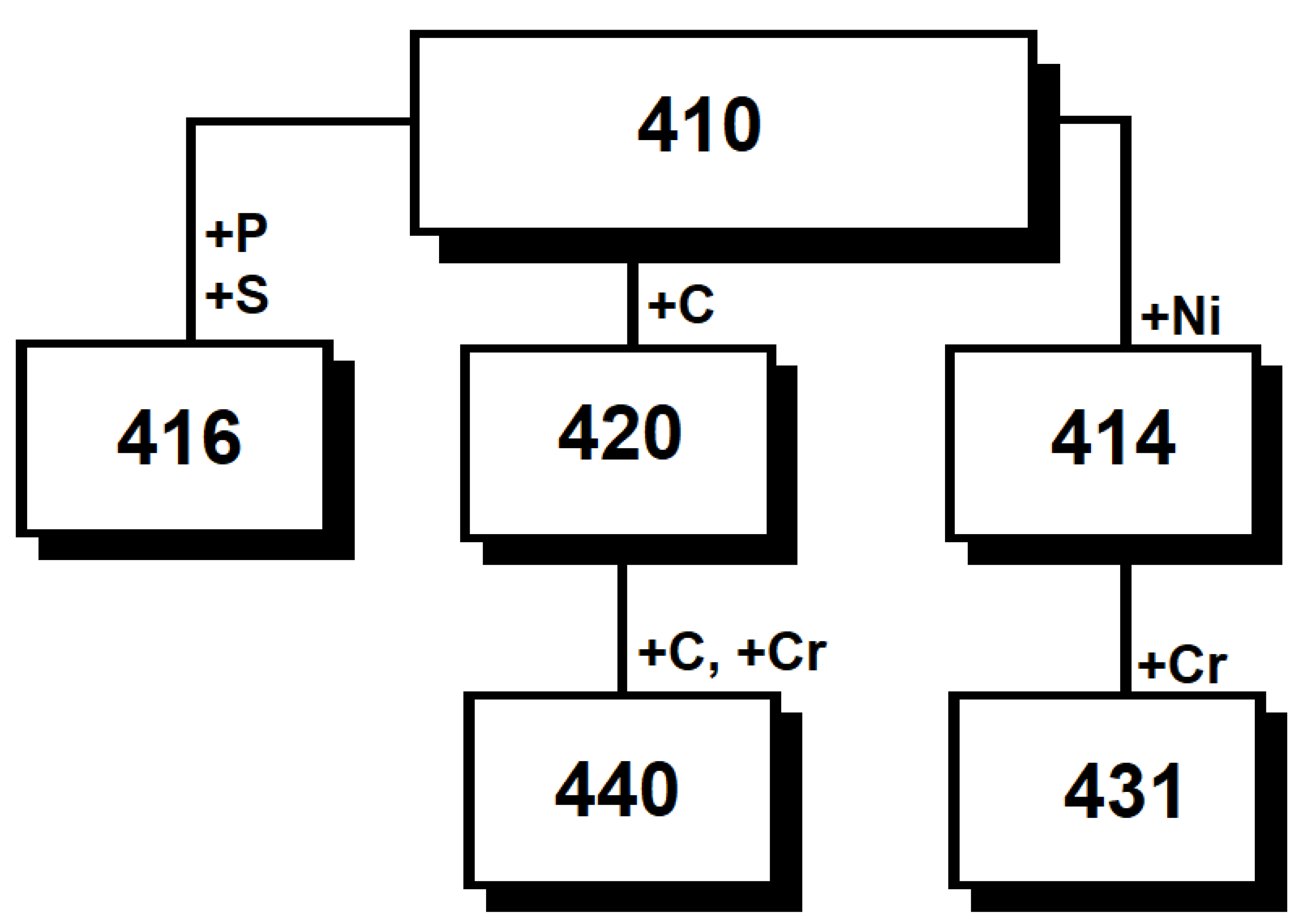

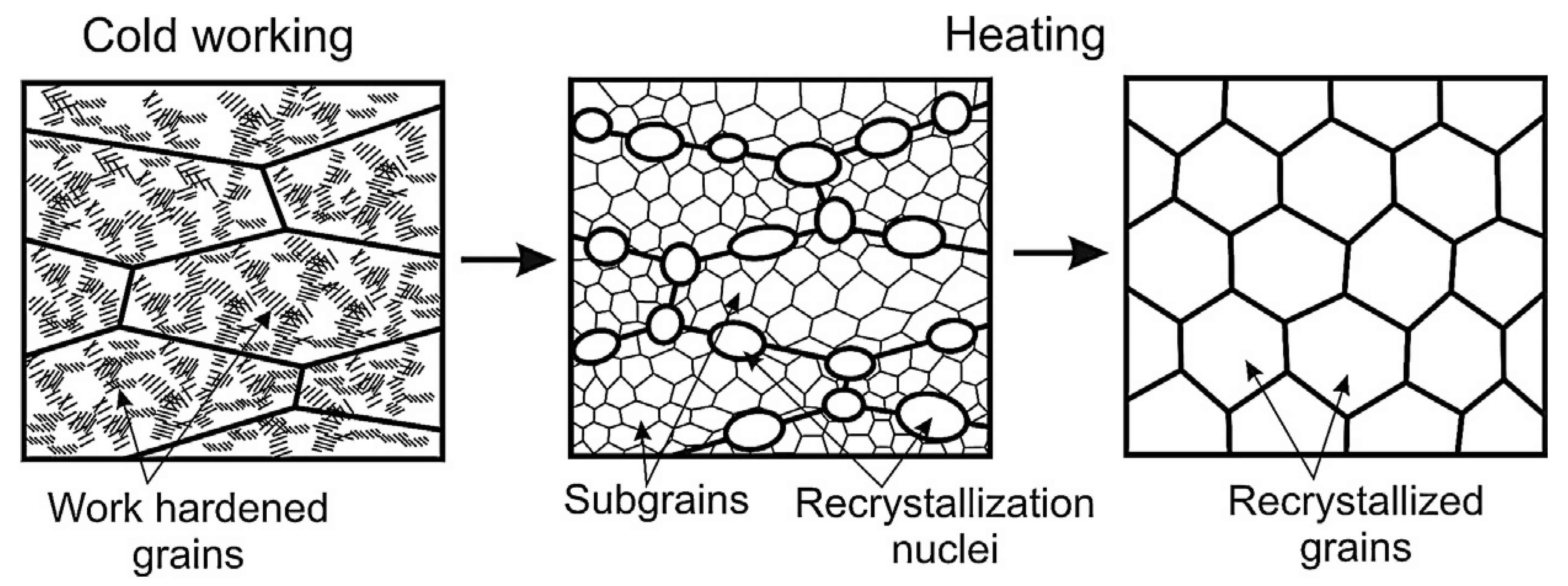

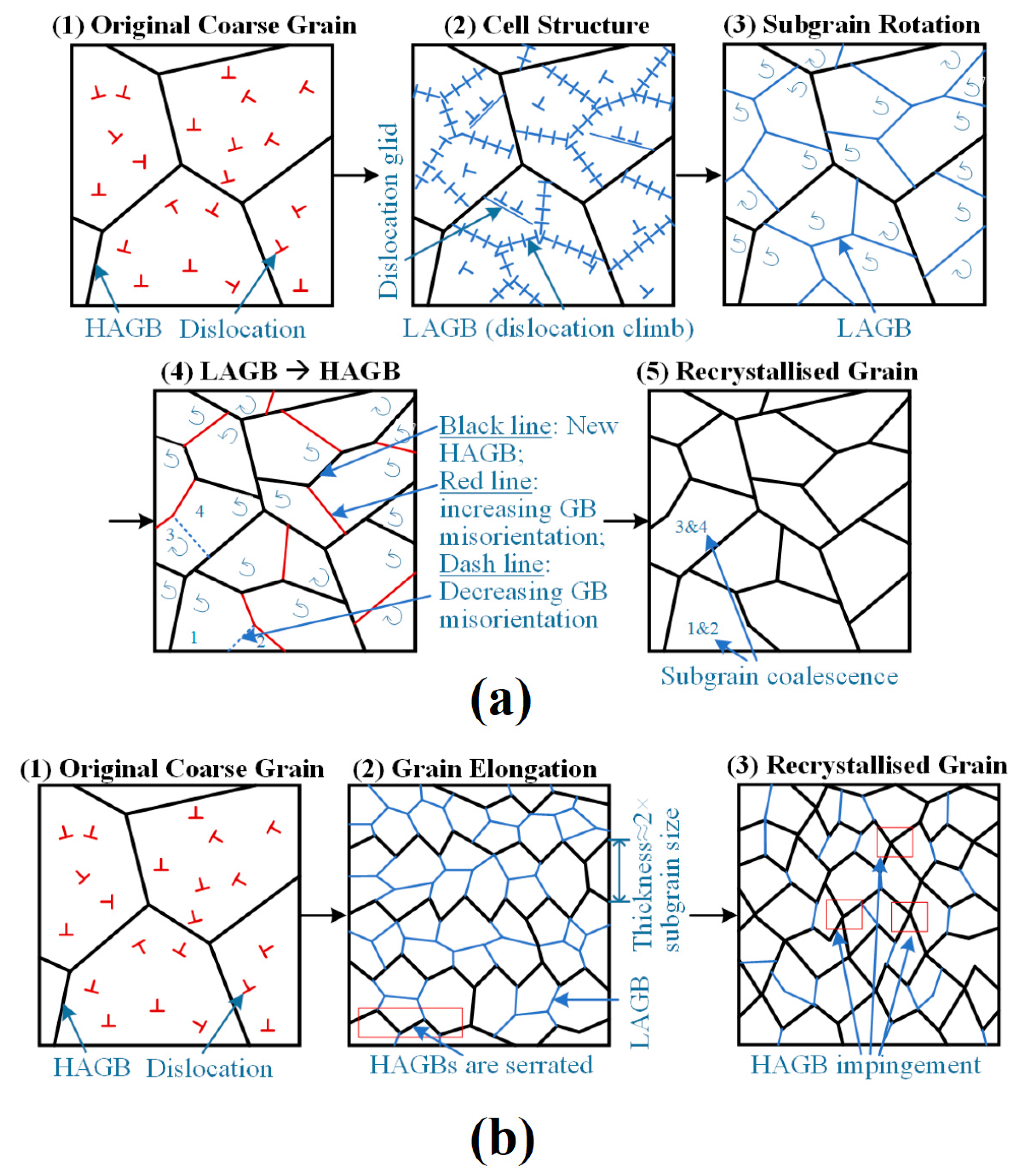
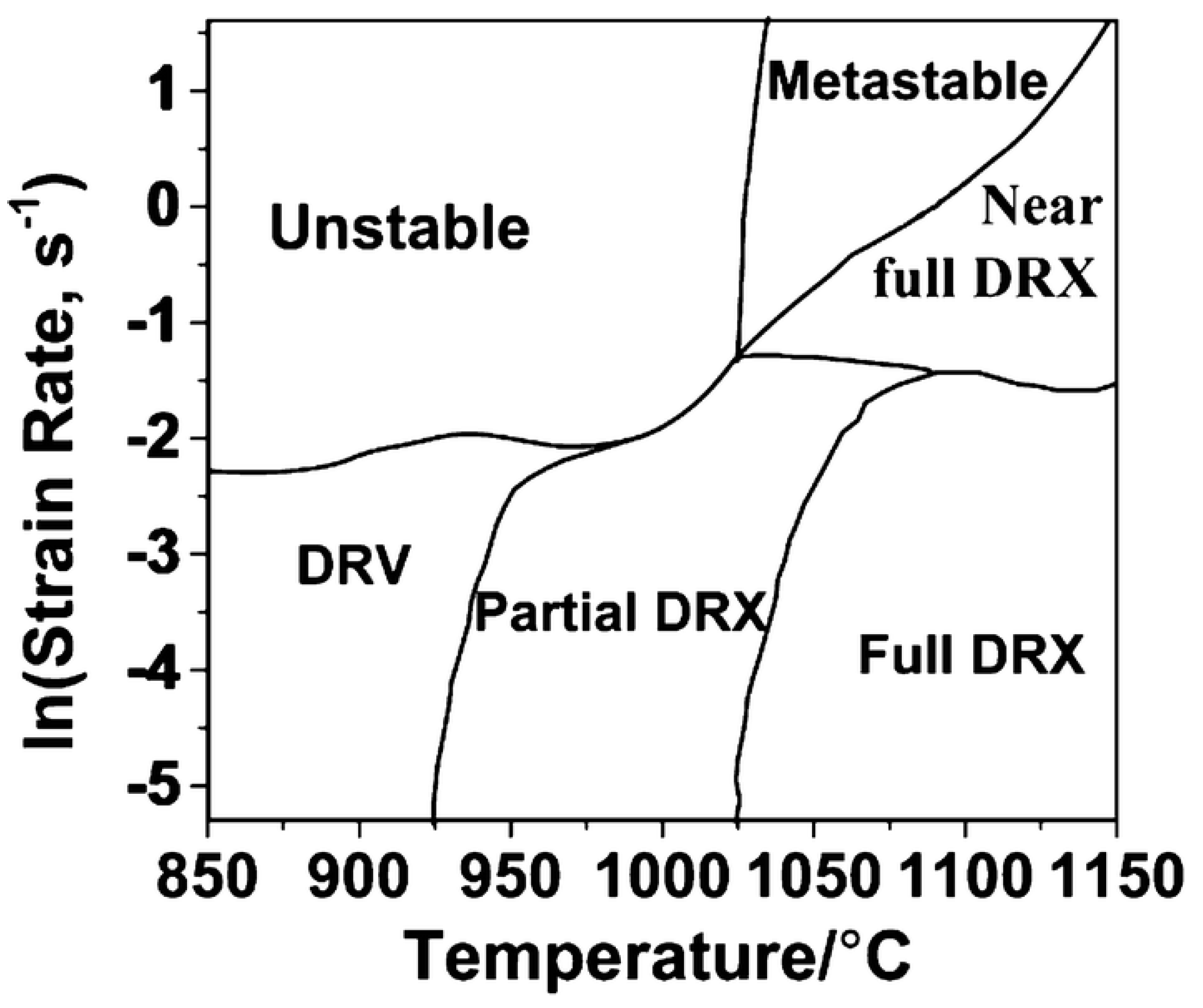
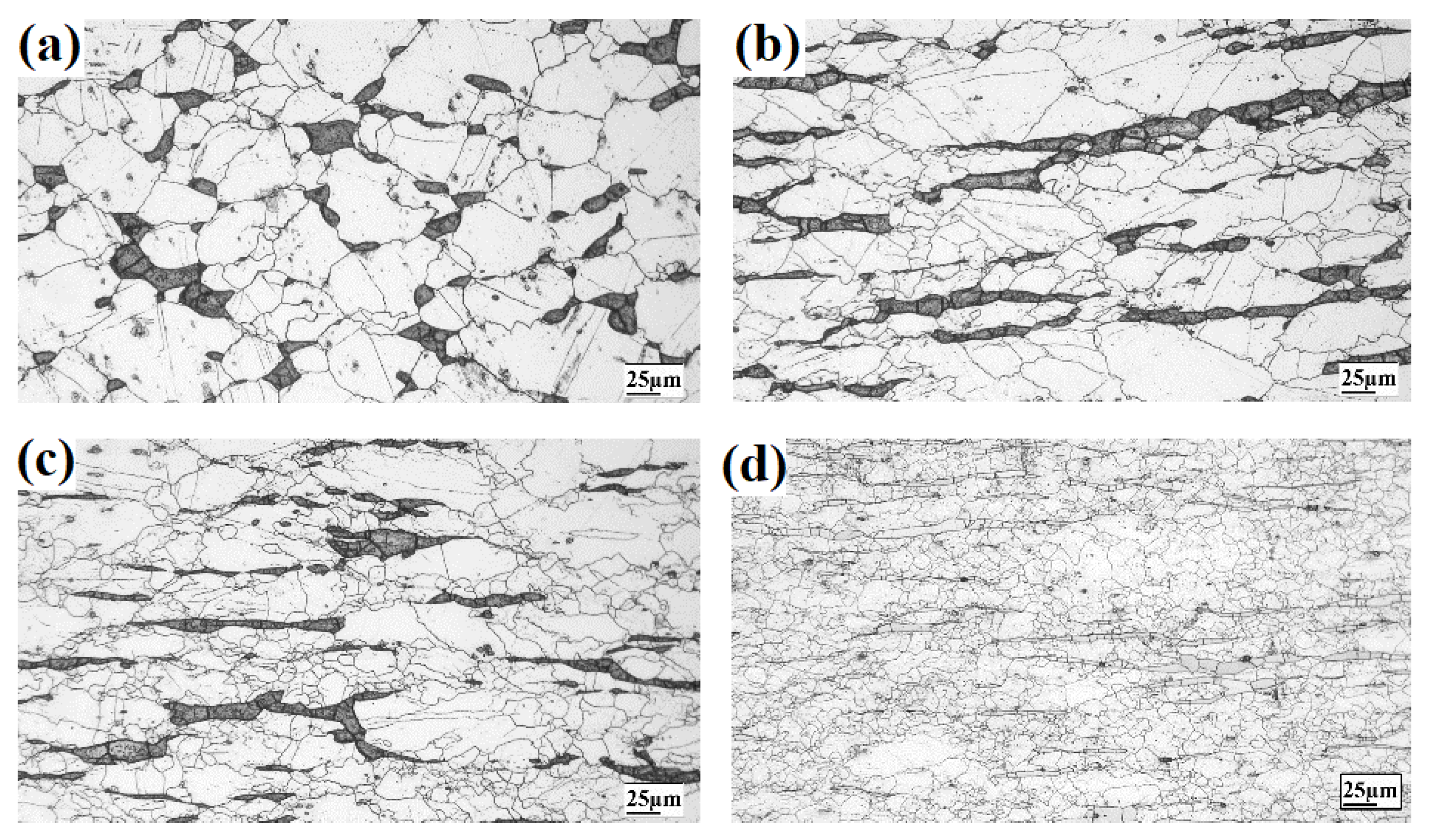
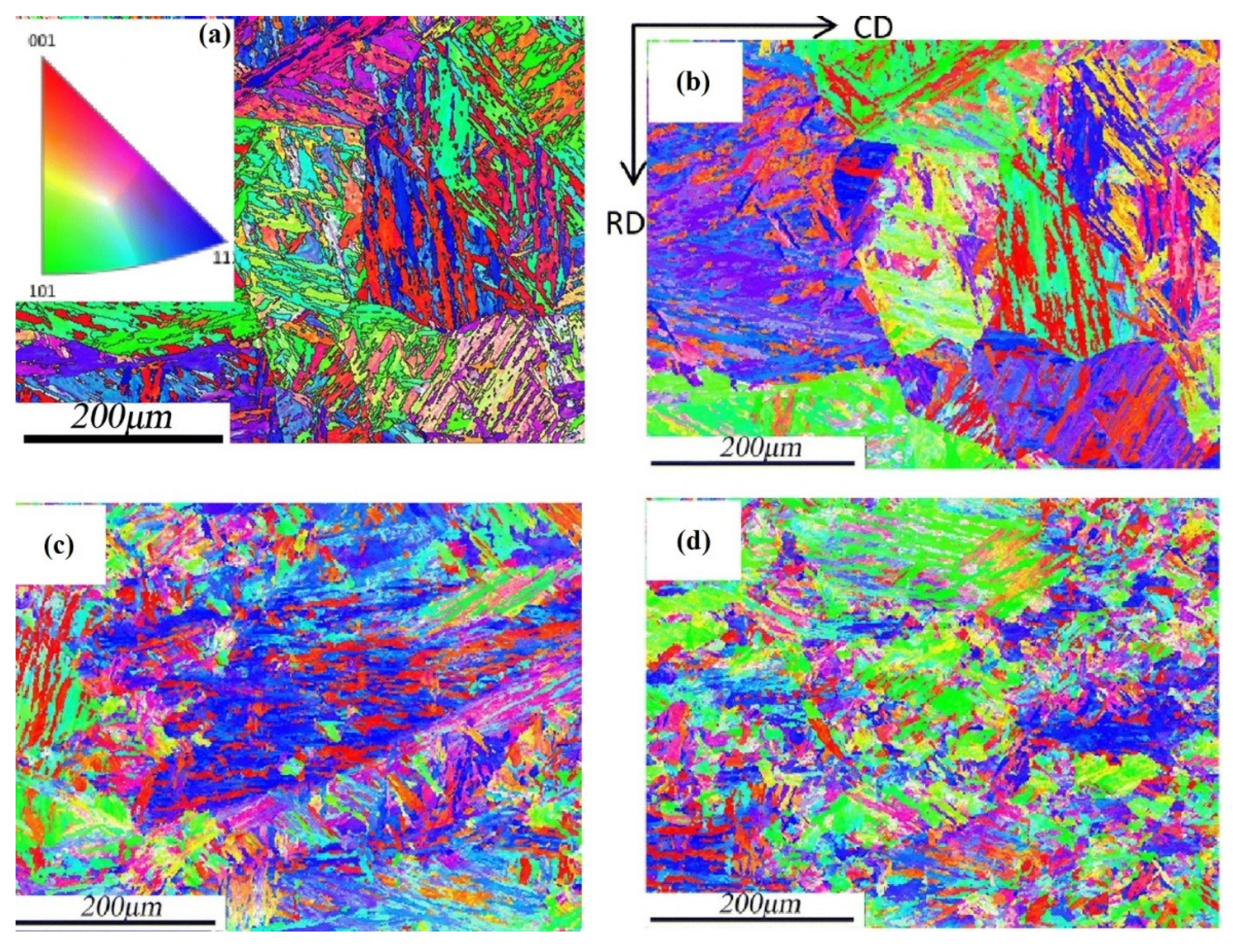

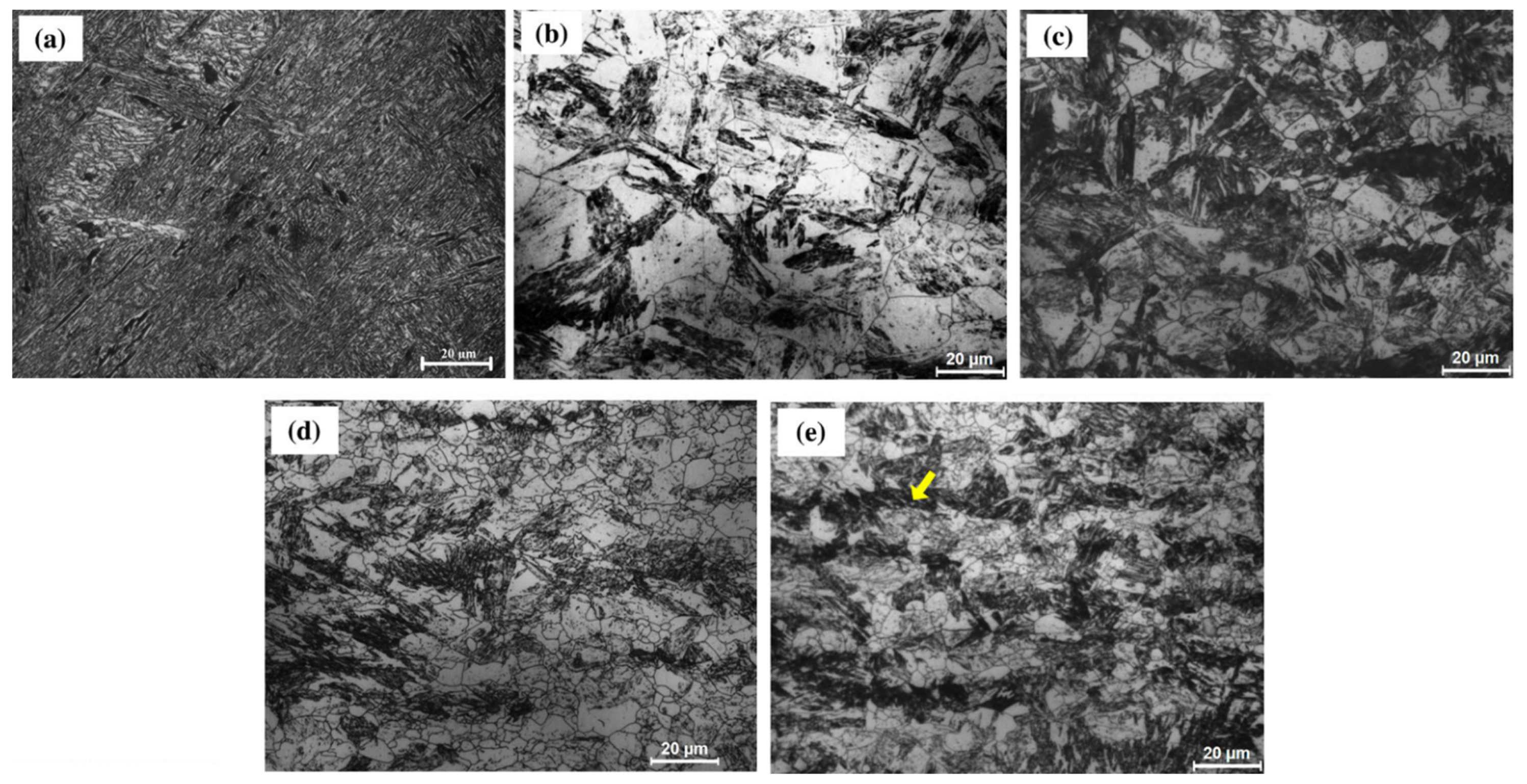
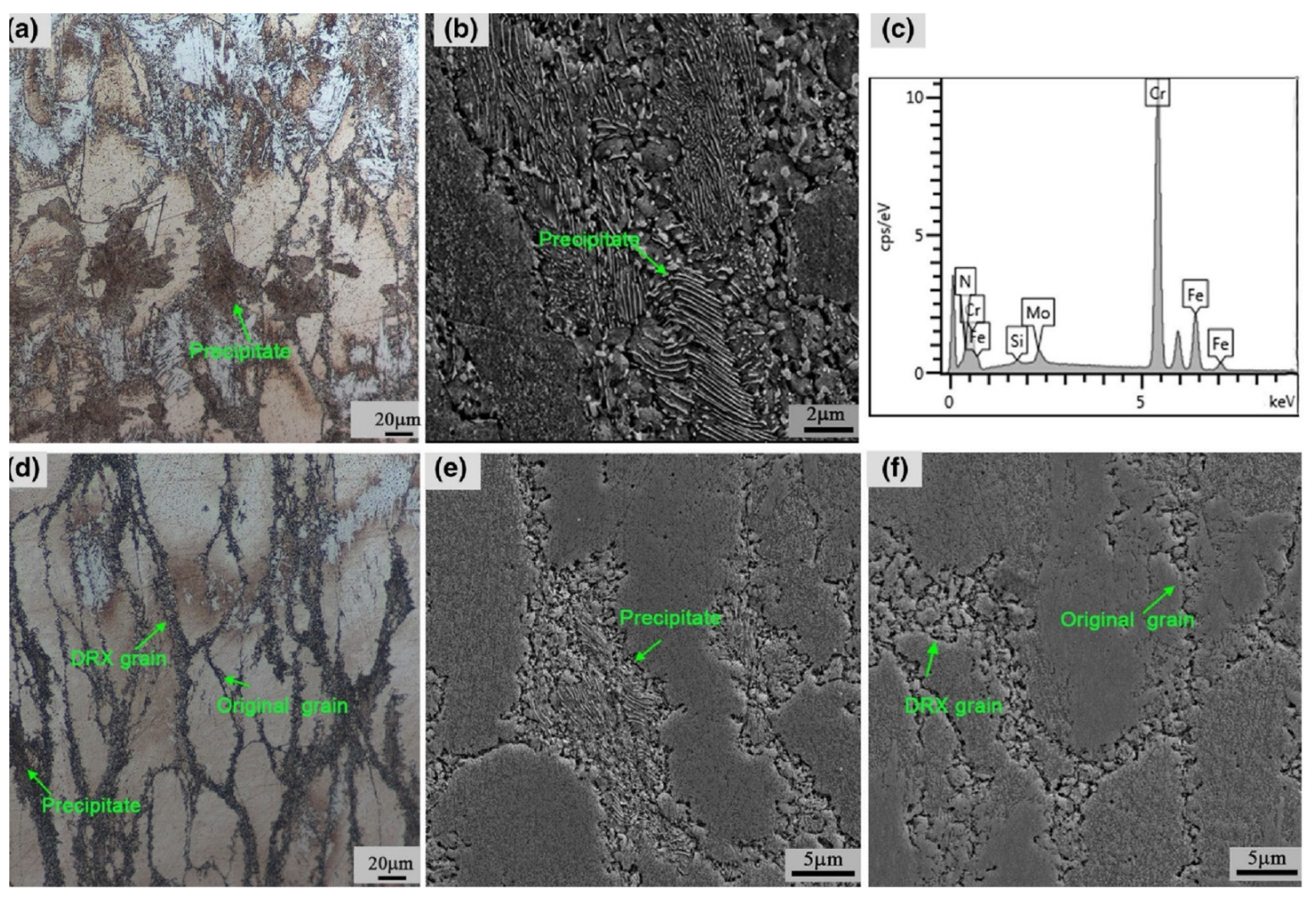
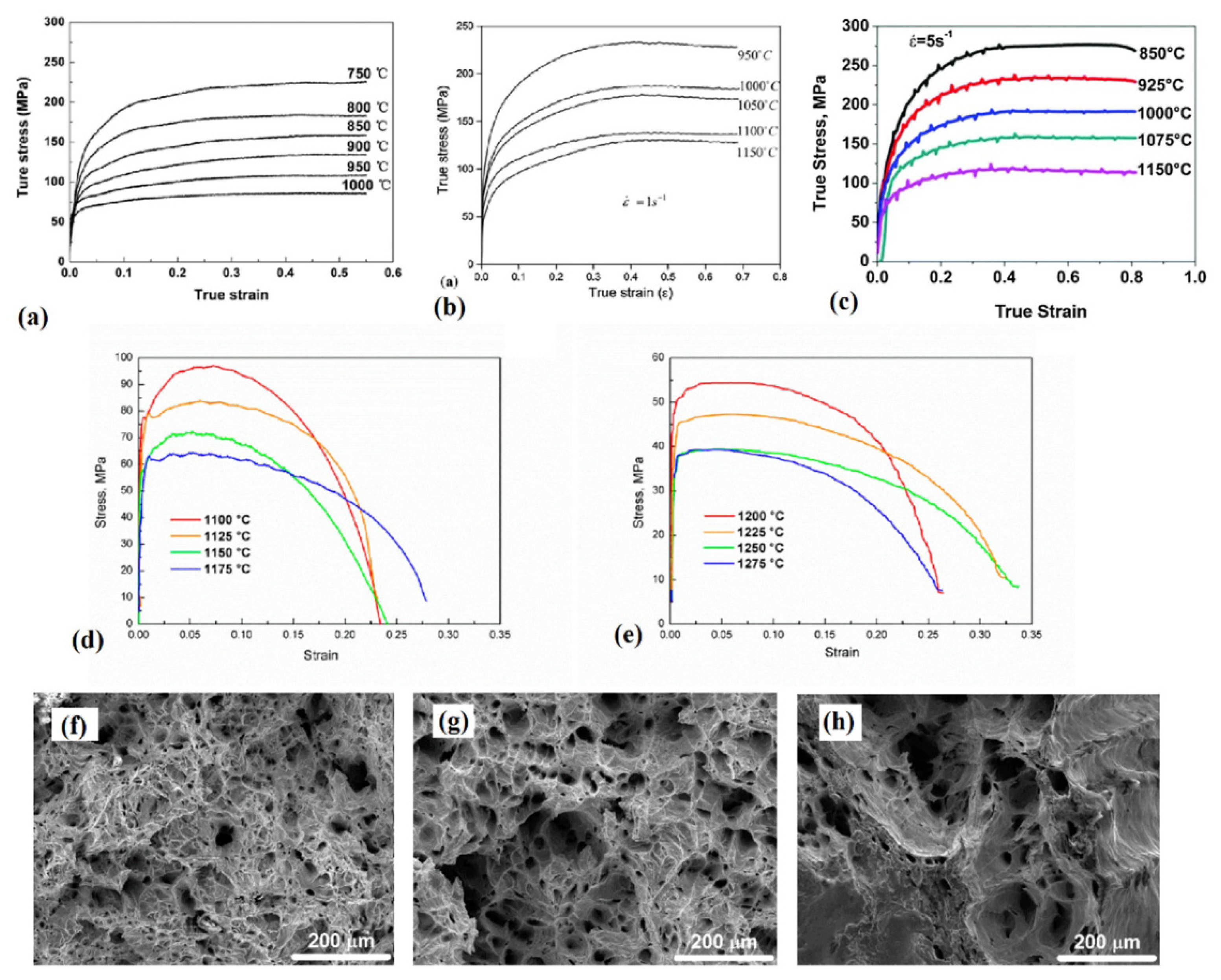
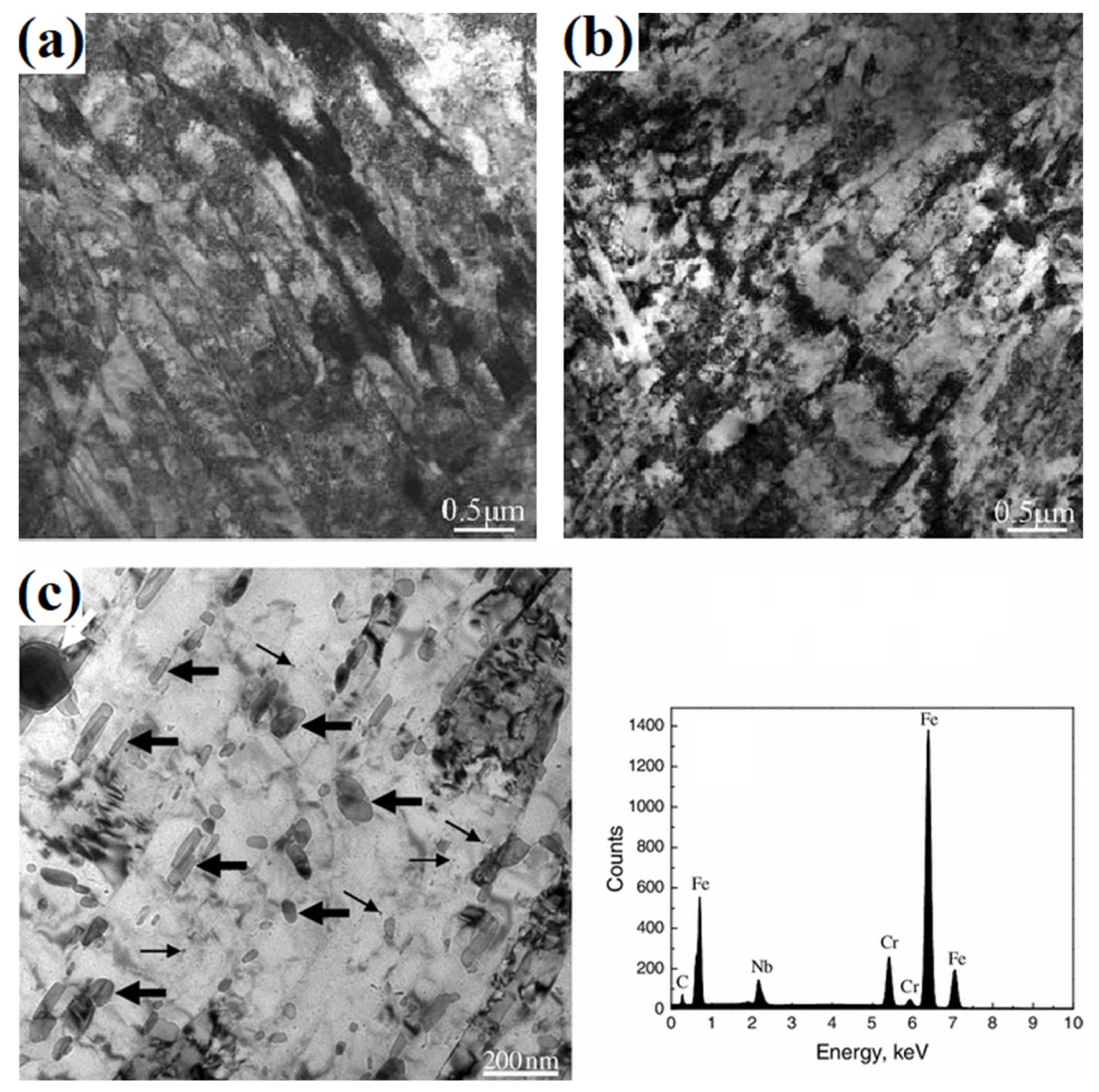
| Grade | C | Mn | Si | Cr | Mo | W | P | V | S | Ref. |
|---|---|---|---|---|---|---|---|---|---|---|
| 410 | 0.15 | 1.0 | 0.5 | 11.5–13 | - | - | 0.04 | - | 0.03 | [19] |
| 416 | 0.15 | 1.25 | 1.0 | 12.0–14.0 | 0.6 | - | 0.04 | - | 0.15 | [20] |
| 420 | 0.15–0.4 | 1.0 | 1.0 | 12.0–14.0 | - | - | 0.04 | - | 0.03 | [21,22] |
| 422 | 0.23 | 1.0 | 0.75 | 12.0 | 1.0 | 1.0 | 0.04 | 0.22 | - | [23] |
| 431 | 0.2 | 1.0 | 1.0 | 15.0–17.0 | 1.25–2.00 | - | 0.04 | - | 0.03 | [24] |
| 440A | 0.60–0.75 | 1.0 | 1.0 | 16.0–18.0 | 0.75 | - | 0.04 | - | 0.03 | [25] |
| 440B | 0.75–0.95 | 1.0 | 1.0 | 16.0–18.0 | 0.75 | - | 0.04 | - | 0.03 | [26] |
| 440C | 0.95–1.20 | 1.0 | 1.0 | 16.0–18.0 | 0.75 | - | 0.04 | - | 0.03 | [27] |
| D2 | 1.50 | 0.3 | 0.25 | 12 | 1.0 | - | - | 1.0 | - | [28] |
| D7 | 2.35 | 0.4 | 0.4 | 12 | 1.0 | - | - | 4.0 | - | [29] |
| 8Cr13MoV | 0.775 | 0.458 | 0.333 | 14.68 | 0.213 | - | 0.031 | 0.182 | 0.004 | [30] |
| Grade | C | Co | Cu | Cr | Si | Mo | Ni | Al | other | Ref. |
|---|---|---|---|---|---|---|---|---|---|---|
| PH15-5 | 0.04 | - | 3.0 | 15 | - | - | 4.7 | - | 0.20 Nb | [29,31] |
| PH7-17 | 0.04 | - | - | 17.06 | 0.385 | - | 7.2 | 1.06 | 0.674 Mn | [32] |
| Custom 450 | 0.04 | - | 1.5 | 11.5 | - | - | 8.5 | - | 0.7 Nb | [33] |
| PH17-4 | 0.07 | - | 3.5 | 16.5 | - | - | 4.0 | - | 0.3 Nb + Ta | [34,35] |
| PH13-8 | 0.03 | - | - | 12.6 | - | 1.7 | 7.9 | 1.0 | - | [36] |
| Custom 465 | 0.02 | - | - | 11.8 | - | 1.0 | 11.0 | - | 1.7 | [37] |
| Custom 455 | 0.05 | - | 2.0 | 11.5 | - | 0.5 | 8.5 | - | 1.1 | [38] |
| SM2Mo | 0.02 | - | - | 12.59 | 0.42 | 1.90 | 5.01 | 0.0062 | [36,39,40] | |
| SM2MoNb | 0.022 | - | - | 12.91 | 0.41 | 2.05 | 5.16 | 0.0043 | [41,42,43] | |
| Pyromet X-15 | 0.01 | 20 | - | 15 | - | 2.9 | - | - | - | [11] |
| Pyromet X-23 | 0.03 | 10 | - | 10 | - | 5.5 | 7.0 | - | - | [11] |
| 2Cr13 | 0.18 | - | - | 12.86 | 0.39 | - | 0.12 | - | 0.53Mn + 0.002S | [44] |
| 00Cr13Ni5Mo2 | 0.013 | - | - | 12.97 | 0.18 | 2.04 | 4.92 | - | 0.59 Mn + 0.001S | [44] |
| 18Cr-5Ni-4Cu-N | 0.06 | - | 4.13 | 17.63 | 0.86 | 2.11 | 5.55 | - | 0.08 Nb + 0.13 V + 0.41 N + 0.025 P | [45] |
Publisher’s Note: MDPI stays neutral with regard to jurisdictional claims in published maps and institutional affiliations. |
© 2021 by the authors. Licensee MDPI, Basel, Switzerland. This article is an open access article distributed under the terms and conditions of the Creative Commons Attribution (CC BY) license (https://creativecommons.org/licenses/by/4.0/).
Share and Cite
Derazkola, H.A.; García Gil, E.; Murillo-Marrodán, A.; Méresse, D. Review on Dynamic Recrystallization of Martensitic Stainless Steels during Hot Deformation: Part I—Experimental Study. Metals 2021, 11, 572. https://doi.org/10.3390/met11040572
Derazkola HA, García Gil E, Murillo-Marrodán A, Méresse D. Review on Dynamic Recrystallization of Martensitic Stainless Steels during Hot Deformation: Part I—Experimental Study. Metals. 2021; 11(4):572. https://doi.org/10.3390/met11040572
Chicago/Turabian StyleDerazkola, Hamed Aghajani, Eduardo García Gil, Alberto Murillo-Marrodán, and Damien Méresse. 2021. "Review on Dynamic Recrystallization of Martensitic Stainless Steels during Hot Deformation: Part I—Experimental Study" Metals 11, no. 4: 572. https://doi.org/10.3390/met11040572







